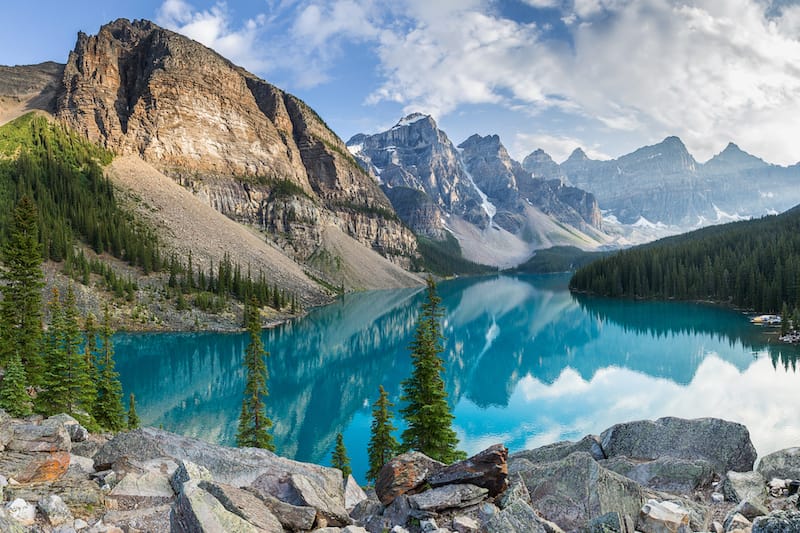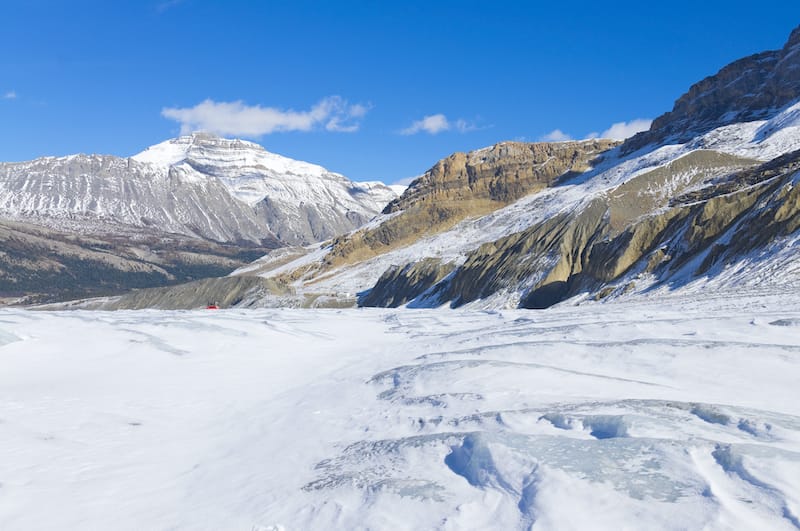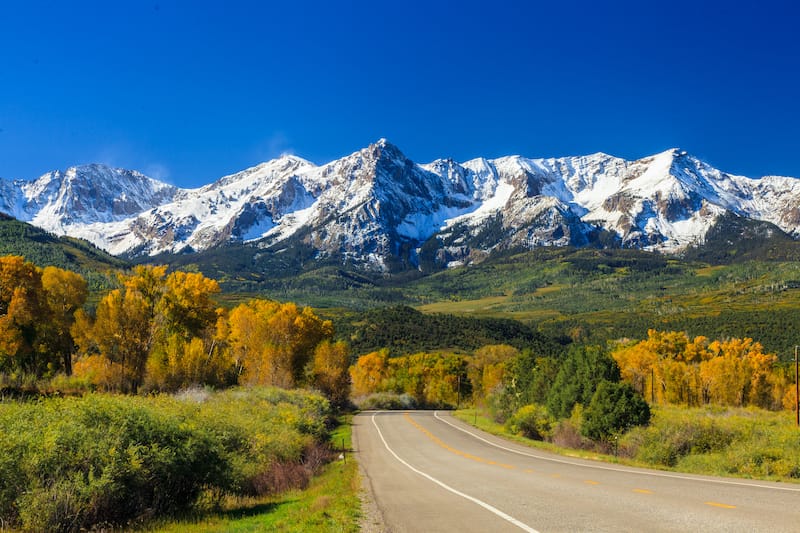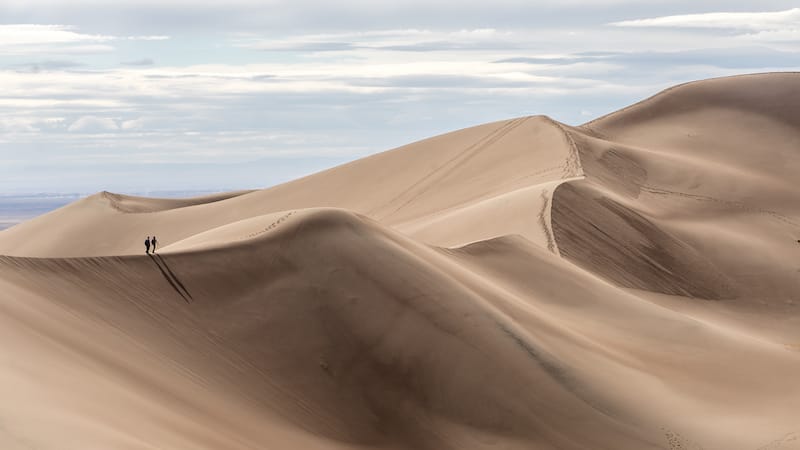Are you keen to know more about the Rocky Mountains? These Rocky Mountains facts will detail everything you should know about one of North America’s most majestic landscapes.
Every year, the Rocky Mountains attract hundreds of thousands of skiers, mountain bikers, and outdoor enthusiasts.
The mountain range stretches for more than 3000 miles over 6 states and it even divides the North American continent with the aptly named Continental Divide.
Here are ten things you probably did not know about the Rocky Mountains. If you have any other Rocky Mountains facts that we left off this list, please drop them in the comments below!

In this post...
- 1. The Rockies are Home to a Supervolcano
- 2. Bighorn Sheep Rule the Rocky Mountains
- 3. There are Still Many Indigenous People Living in the Rockies
- 4. Athabasca Glacier is the Most-Visited Glacier in North America
- 5. Mount Elbert is the Highest Peak in the Rocky Mountains
- 6. The Rocky Mountains Divide the North American Continent
- 7. The Rocky Mountains are 80 Million to 55 Million Years Old
- 8. Francisco Vásquez de Coronado was the First Explorer
- 9. The Rocky Mountains Contain Massive Sand Dunes
- 10. There are Nine National Parks in the Rocky Mountains
- Facts about the Rocky Mountains: Pin This Guide!
1. The Rockies are Home to a Supervolcano
Did you know that a supervolcano lies hidden in the Rocky Mountains?
The volcano is located in Yellowstone National Park and goes by the name Yellowstone Caldera. This is one of the reasons why you can see geysers in Yellowstone and why there is an overpowering smell of phosphorus in the air throughout the national park.
As the volcano’s eruptions occur millions of years apart, we will probably not see the Yellowstone volcano erupt in our lifetime, but never say never! Other signs of volcanic activity can be seen all over the Rocky Mountains, such as at the hot springs in Grand County.
Yellowstone National Park is one of the most visited US national parks and this supervolcano helps create the sights that we flock there to see! Click here if you’re actually planning a trip there and looking for some fantastic Yellowstone accommodation!
2. Bighorn Sheep Rule the Rocky Mountains
Don’t be scared if you see a sheep with thick, large horns on its head in the Rocky Mountains. This is the Bighorn Sheep, and it is the unofficial mascot of the Rocky Mountains.
There are some 400 of these large sheep wandering through Rocky Mountain National Park, and they are known to be very gentle and kind. You have the biggest chance of seeing them from May to June.
3. There are Still Many Indigenous People Living in the Rockies
The high peaks and plains of the Rocky Mountains are still home to numerous indigenous people. You will find reserves for the Bannock, Sioux, Blackfoot, Cow People, Apache, Kutenai, and many more.
In recent years, some national parks, including Rocky Mountain National Park, have tried to expand their representation of Native Americans in the park. They are partnering with the University of Colorado’s Indigenous-focused groups and representatives to do so.
Rocky Mountain National Park is on the unceded land of the Ute, Arapaho, Cheyenne, and Comanche peoples. We ask you to join us in acknowledging their communities, their elders both past and present, as well as future generations.
We also acknowledge that Rocky Mountain National Park was founded upon exclusions and erasures of many Indigenous peoples, including those on whose land these US National Parks are located.
4. Athabasca Glacier is the Most-Visited Glacier in North America
The Athabasca Glacier, part of the Canadian Rocky Mountains, is the most-visited glacier in North America. The glacier is about 4 miles long, and the ice on the glacier runs between 100 and 1000 feet deep.
The Athabasca Glacier is also one of the most important symbols of climate change. Because of climate change, the glacier has already retracted 1 mile in the past 125 years.

At the moment, the glacier retreats at a rate of 10 feet per year. It is not a good idea to walk the glacier without a guide because of the cracks, and it is extremely treacherous.
There have been incidents in the past where tourists fell through the cracks, eventually leading to hypothermia and death.
5. Mount Elbert is the Highest Peak in the Rocky Mountains
The highest peak in the Rocky Mountains is Mount Elbert. Mount Elbert is located in the state of Colorado and is 4401 meters high, or 14,440 feet.
This is also why Mount Elbert is called a ‘fourteener’. Because the Colorado mountain is relatively easy to climb, it is a very popular mountain with climbers, hikers, and other adventurers.
Mount Elbert was named in honor of a Colorado statesman. Samuel Hitt Elbert was active in the formative period of the state of Colorado and was even governor of the state from 1873 to 1874.
Henry Stuckle was the first person to record climbing Mount Elbert in 1874. The mountain has the moniker 'Gentle Giant' as it is a class 1 to 2, meaning it is an ideal mountain for beginning mountaineers.
While we view the Rockies as majestic and very high in North America, there are actually 100 mountains higher in Asia (Nepal, China, India, and Pakistan).
So, while you can practice for your Everest Base Camp Trek in the Rockies, don't count on the actual Base Camp hike to be any easier than the mountains you will practice on!
6. The Rocky Mountains Divide the North American Continent
Did you know that all the rivers on the west side of the Rocky Mountains flow to the Pacific Ocean while all the rivers on the east side of the Rocky Mountains flow into the Atlantic Ocean?
This is because the Rocky Mountains divide North America, earning them the name of the Continental Divide.

The continental divide of North America extends from the Bering Strait to the Strait of Magellan.
7. The Rocky Mountains are 80 Million to 55 Million Years Old
The Rocky Mountains were formed 80 million to 55 million years ago in the Laramide orogeny. The Laramide Orogeny is a period where many of the North American mountains were shaped into the mountains we know today.
During this time, the Kula and Farallon plates slid underneath the North American Plate. There was magma formation in the east, which meant the Ricky Mountains could be formed.
Other mountains that were formed during this time are the Laramie Mountains and the Black Mountains in Wyoming.
8. Francisco Vásquez de Coronado was the First Explorer
The Spanish explorer, Francisco Vásquez de Coronado, was the very first explorer to walk into the Rocky Mountains. His army and he marched into the mountain range from the south in 1540. He was looking for the Seven Cities of Gold.
These 'cities of gold' were supposed to be found in the Rockies of New Mexico. The cities of gold were: El Dorado, Paititi, the City of Caesars, Lake Parime at Manoa, Antilia, Quivira, and Cibola.
The stories of these cities were probably based on the legends of the Portuguese about cities of gold on the island of Antillia in the 8th century and the capture of Merida in Spain by the Moors.
9. The Rocky Mountains Contain Massive Sand Dunes
The Rocky Mountains contain the highest dunes in North America. Great Sand Dunes National Park allows you to climb beautiful dunes that are flanked by the high, white peaks of the Rocky Mountains.
Some of the dunes are more than 750 feet high!

The valley was filled with lakes that later receded. The lakes left sand that was then blown into sand dunes by the southwest winds in the valley over a period of tens of thousands of years.
Great Sand Dunes National Park is a bit remote, but if you can add an extra day onto a journey from Colorado to California, you should make the detour!
10. There are Nine National Parks in the Rocky Mountains
Because the Rocky Mountains span 3000 miles, 6 states, and 2 countries, you can imagine that there is a lot of room for beautiful and expansive national parks in the Rocky Mountains.
There are no fewer than nine national parks in the Rockies, with Yellowstone and Rocky Mountain National Park being two of the most famous. The US National Parks in the Rocky Mountains are:
- Badlands National Park
- Black Canyon of the Gunnison National Park
- Glacier National Park
- Grand Teton National Park
- Great Sand Dunes National Park
- Rocky Mountain National Park
- Theodore Roosevelt National Park
- Wind Cave National Park
- Yellowstone National Park
This article was written by Lieze Neven. Lieze Neven is a travel blogger currently living in Nepal. Read more about the Rocky Mountains, skiing in the Rockies, and where to stay on your Rocky Mountain ski holiday in Winter Park on her blog.
READ MORE:
- Visiting Grand Teton National Park in winter
- Best Airbnbs near Grand Teton
- Yellowstone itinerary
- What to do in Yellowstone during winter
- Calgary in winter travel guide
- 7 days in the Canadian Rockies
Facts about the Rocky Mountains: Pin This Guide!

Megan is a travel blogger and writer with a background in digital marketing. Originally from Richmond, VA, she now splits her time between Frankfurt, Germany and Arctic Finland after also living in Norway, Armenia, and Kazakhstan. She has a passion for winter travel, as well as the Nordic countries, but you can also find her eating her way through Italy, perusing perfume stores in Paris, or taking road trips through the USA. Megan has written for or been featured by National Geographic, Forbes, Lonely Planet, the New York Times, and more. She co-authored Fodor’s Travel ‘Essential Norway’ and has visited 45 US states and 100+ countries.


Cool
I didn’t Know any of this.
Two clarifications
1. Water on the eastern side of N.A. Rockies flows to Gulf of Mexico as well as The Atlantic (probably close to half +/_)
2. Vasquez de Coronado et al were far from the 1st explorers.
The 1st Nations beat them by at least twenty thousand years.
Megan and Adam, I truly appreciate the articles. Very interesting. I love in Arizona and I have been to part of then Rockies before. You should see some of the stuff we have here in Arizona.
Great guide and some beautiful photography!
I agree